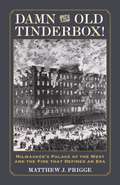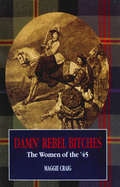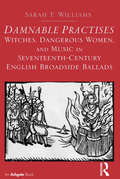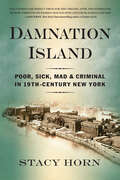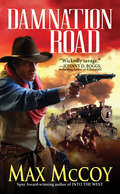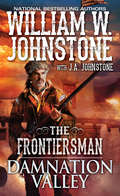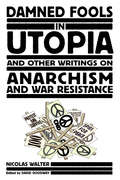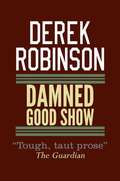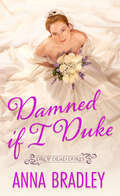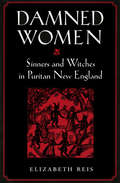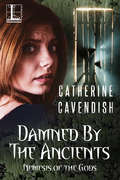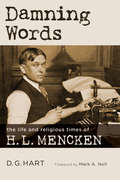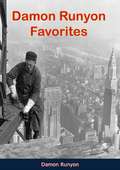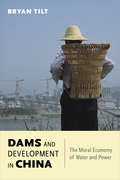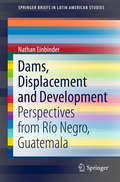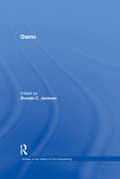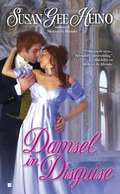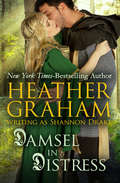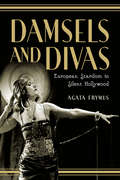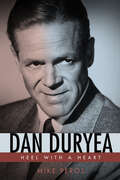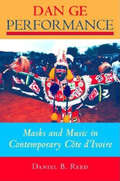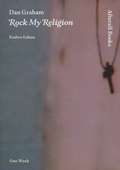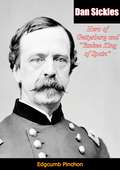- Table View
- List View
Damn the Old Tinderbox!: Milwaukee's Palace of the West and the Fire That Defined An Era
by Matthew J. PriggeIn the dead of an unassuming January night in 1883, Milwaukee’s Newhall House hotel was set on fire. Two hours later, the building—once among the tallest in the nation—lay in ruins and more than seventy people were dead. It was a tragedy that brought global notice to Milwaukee, with daring escapes, unlikely rescues, and heart-wrenching tales of victims burned to death or killed as they leapt from the burning building. From the great horror emerged an even greater string of mysteries: Who had set the fire, and who was to blame for the staggering loss of life? The Newhall’s hard-luck barkeeper? A gentleman arsonist? What about the many other unexplained fires at the hotel? Had the Newhall’s management neglected fire safety to boost profits? Would the true number of victims ever be known?
Damn' Rebel Bitches: The Women of the '45
by Maggie CraigDamn' Rebel Bitches takes a totally fresh approach to the history of the Jacobite Rising by telling fascinating stories of the many women caught up in the turbulent events of 1745-46. Many historians have ignored female participation in the '45: this book aims to redress the balance. Drawn from many original documents and letters, the stories that emerge of the women - and their men - are often touching, occasionally light-hearted and always engrossing.
Damnable Practises: Witches, Dangerous Women, And Music In Seventeenth-century English Broadside Ballads
by Sarah F. WilliamsBroadside ballads-folio-sized publications containing verse, a tune indication, and woodcut imagery-related cautionary tales, current events, and simplified myth and history to a wide range of social classes across seventeenth century England. Ballads straddled, and destabilized, the categories of public and private performance spaces, the material and the ephemeral, music and text, and oral and written traditions. Sung by balladmongers in the streets and referenced in theatrical works, they were also pasted to the walls of local taverns and domestic spaces. They titillated and entertained, but also educated audiences on morality and gender hierarchies. Although contemporaneous writers published volumes on the early modern controversy over women and the English witch craze, broadside ballads were perhaps more instrumental in disseminating information about dangerous women and their acoustic qualities. Recent scholarship has explored the representations of witchcraft and malfeasance in English street literature; until now, however, the role of music and embodied performance in communicating female transgression has yet to be investigated. Sarah Williams carefully considers the broadside ballad as a dynamic performative work situated in a unique cultural context. Employing techniques drawn from musical analysis, gender studies, performance studies, and the histories of print and theater, she contends that broadside ballads and their music made connections between various degrees of female crime, the supernatural, and cautionary tales for and about women.
Damnation Island: Poor, Sick, Mad, and Criminal in 19th-Century New York
by Stacy Horn<P><P>On a two-mile stretch of land in New York’s East River, a 19th-century horror story was unfolding . . . <P><P>Today we call it Roosevelt Island. Then, it was Blackwell’s, site of a lunatic asylum, two prisons, an almshouse, and a number of hospitals. <P><P>Conceived as the most modern, humane incarceration facility the world ever seen, Blackwell’s Island quickly became, in the words of a visiting Charles Dickens, “a lounging, listless madhouse.” <P><P>In the first contemporary investigative account of Blackwell’s, Stacy Horn tells this chilling narrative through the gripping voices of the island’s inhabitants, as well as the period’s officials, reformers, and journalists, including the celebrated Nellie Bly. <P><P>Digging through city records, newspaper articles, and archival reports, Horn brings this forgotten history alive: there was terrible overcrowding; prisoners were enlisted to care for the insane; punishment was harsh and unfair; and treatment was nonexistent. <P><P>Throughout the book, we return to the extraordinary Reverend William Glenney French as he ministers to Blackwell’s residents, battles the bureaucratic mazes of the Department of Correction and a corrupt City Hall, testifies at salacious trials, and in his diary wonders about man’s inhumanity to man. <P><P>In Damnation Island, Stacy Horn shows us how far we’ve come in caring for the least fortunate among us—and reminds us how much work still remains.
Damnation Road
by Max McCoyThe Daring And The Doomed. . .It's the last chance for Jacob Gamble, Rough Rider, outlaw and man of a few principles. Nearing 50 and flat broke, Jacob bends his own rule about robbing trains. But by the time he reaches the payroll safe on a Rock Island train, he finds another thief there first with a bullet in his head. Jacob is caught holding the bag--and turned into hero. A broke hero. In A Place Called Damnation Road. . .Shackled by unwanted fame, running from a life gone wrong, and raising the suspicions of a Pinkerton detective, Jacob listens to a woman: beautiful and tattooed by the Indians who seized her as a child. Olivia Weathers knows of a treasure hidden in a cave along the Jornada del Muerto--a merciless hundred mile stretch of hell on earth guarded by Apache warriors. Now, Jacob will follow Olivia into the most savage and deadly territory in the southwest--where few ever come out of Canyon Diablo alive. "Max McCoy is a masterful storyteller. A force of fascinating characters and unexpected plot twists create a can't-put-it-down story." --Cotton Smith, author of Spirit Rider
Damnation Valley (The Frontiersman #4)
by William W. Johnstone J.A. JohnstoneIn this western adventure by the bestselling authors of The Darkest Winter, a fearless pioneer vigilante hunts for justice in a town teeming with sin. A Rocky Mountain winter has left Breck reeling from the carnage unleashed by bloodthirsty trapper Judd Carnahan—and readying a quest for vengeance as ruthless as their prey. It gets even deadlier when Carnahan lays siege to a trading post on the Yellowstone River. He&’s left the owner dead and kidnapped a pretty hostage who can turn a nice profit once he puts her to work. Following his trail takes Breck clean to Santa Fe, where Carnahan&’s set up a brothel bursting with hardened beauties, a saloon for cutthroats and thieves, and a trap for the Frontiersman who&’s tracked him every bloody step of the way. But over the rough, merciless miles it&’s taken Breck to get here, he&’s built up a raging fury that&’s going to make this unholy town swim in blood.
Damned Fools in Utopia: And Other Writings on Anarchism and War Resistance
by Nicolas WalterA hefty collection of noted anarchist Nicolas Walter's writings, this history recounts the anarchist and peace movements in the United Kingdom alongside the author's adventures through activism. Inspired by the Suez and Hungarian Revolutions and his participation in the New Left, Walter became an anarchist and proponent of the freethought movement. Recounting his personal history in two autobiographical pieces, the author reflects on his militant involvement in the British nuclear disarmament movement, his experience as one of the Spies of Peace, and his connection to the Solidarity group. As an activist, Walter concurrently analyzed history, political theory, and activist practices, which he combined to form the backbone upon which he built his beliefs. Also included are musings on various intellectual and political figures such as George Orwell, Herbert Read, C. W. Daniel, and Guy A. Aldred, in addition to ruminations on the atheism and rationalism and the limitations of academia.
Damned Good Show
by Derek RobinsonThey joined an R.A.F. known as 'the best flying club in the world', but when war pitches the young pilots of 409 Squadron into battle over Germany, their training, tactics and equipment are soon found wanting, their twin-engined bombers obsolete from the off. Chances of completing a 30-operation tour? One in three. At best. Robinson's crooked salute to the dogged heroes of the R.A.F.'s early bombing campaign is a wickedly humourous portrait of men doing their duty in flying death traps, fully aware, in those dark days of war, there was nothing else to do but dig in and hang on.
Damned Good Show
by Derek RobinsonThey joined an R.A.F. known as 'the best flying club in the world', but when war pitches the young pilots of 409 Squadron into battle over Germany, their training, tactics and equipment are soon found wanting, their twin-engined bombers obsolete from the off. Chances of completing a 30-operation tour? One in three. At best. Robinson's crooked salute to the dogged heroes of the R.A.F.'s early bombing campaign is a wickedly humourous portrait of men doing their duty in flying death traps, fully aware, in those dark days of war, there was nothing else to do but dig in and hang on.
Damned If I Duke (Drop Dead Dukes #2)
by Anna BradleyA sensible duke wants a dutiful duchess. A rakish duke wants no bride at all. But a truly wise man knows the pleasure of finding a wife who&’s his match in every way . . . Bold and adventurous, Prudence Thorne is not the kind of woman to stand by meekly when someone she loves has been wronged. And she&’s quite certain that Jasper Vincent, Duke of Montford, somehow duped her father into racking up enormous gambling debts. When fate offers her a chance to blackmail Jasper into forgiving her father&’s losses, she seizes it . . . only to have her scheme backfire. Jasper enjoys London&’s illicit delights too much to wed. Too bad his grandfather has decided that a woman with the nerve to blackmail might be exactly the sort of wife to tame him. Pressed into a marriage neither wanted—and fighting a desire neither expected—Prue and Jasper torment and tempt each other beyond reason. Surely a proper duchess should be subdued, obedient, and dignified? Yet just as he begins to get his wish, Jasper realizes how much he wants his unconventional wife—and only her—if it&’s not too late to win her . . .
Damned Women: Sinners and Witches in Puritan New England
by Elizabeth ReisIn her analysis of the cultural construction of gender in early America, Elizabeth Reis explores the intersection of Puritan theology, Puritan evaluations of womanhood, and the Salem witchcraft episodes. She finds in those intersections the basis for understanding why women were accused of witchcraft more often than men, why they confessed more often, and why they frequently accused other women of being witches. In negotiating their beliefs about the devil's powers, both women and men embedded womanhood in the discourse of depravity.Puritan ministers insisted that women and men were equal in the sight of God, with both sexes equally capable of cleaving to Christ or to the devil. Nevertheless, Reis explains, womanhood and evil were inextricably linked in the minds and hearts of seventeenth-century New England Puritans. Women and men feared hell equally but Puritan culture encouraged women to believe it was their vile natures that would take them there rather than the particular sins they might have committed.Following the Salem witchcraft trials, Reis argues, Puritans' understanding of sin and the devil changed. Ministers and laity conceived of a Satan who tempted sinners and presided physically over hell, rather than one who possessed souls in the living world. Women and men became increasingly confident of their redemption, although women more than men continued to imagine themselves as essentially corrupt, even after the Great Awakening.
Damned by the Ancients (Nemesis of the Gods #3)
by Catherine CavendishINFINITY IN DEATH Vienna, 1908 Gabriele Ziegler is a young art student who becomes infatuated with charismatic archeologist Dr. Emeryk Quintillus. Only too late does she realize his true designs on her. He is obsessed with resurrecting Cleopatra and has retained the famed artist Gustav Klimt to render Gabriele as the Queen of the Nile, using ashes from Cleopatra’s mummy mixed with the paint. The result is a lifelike portrait emitting an aura of unholy evil . . . Vienna, 2018 The Mortimer family has moved into Quintillus’s former home, Villa Dürnstein. In its basement they find an original Klimt masterpiece—a portrait of Cleopatra art scholars never knew existed. But that’s not all that resides within the villa’s vault. Nine-year-old Heidi Mortimer tells her parents that a strange man lives there. Quintillus’s desire to be with Cleopatra transcends death. His spirit will not rest until he has brought her back from the netherworld. Even if he has to sacrifice the soul of a child . . .
Damning Words: The Life and Religious Times of H. L. Mencken
by D. G. HartRecounts a famously outspoken agnostic's surprising relationship with Christianity H. L. Mencken (1880–1956) was a reporter, literary critic, editor, author—and a famous American agnostic. From his role in the Scopes Trial to his advocacy of science and reason in public life, Mencken is generally regarded as one of the fiercest critics of Christianity in his day. In this biography D. G. Hart presents a provocative, iconoclastic perspective on Mencken's life. Even as Mencken vividly debunked American religious ideals, says Hart, it was Christianity that largely framed his ideas, career, and fame. Mencken's relationship to the Christian faith was at once antagonistic and symbiotic. Using plenty of Mencken's own words, Damning Words superbly portrays an influential figure in twentieth-century America and, at the same time, casts telling new light on his era.
Damon Runyon Favorites: Favorites
by Damon Runyon Walter WinchellMASTER OF THE MAIN STEM!Here are some stories by Damon Runyon—the man who, according to Walter Winchell, knows more about the Roaring Forties than any other writing man. Included are many of the stories that have made him famous. There are “Little Miss Marker,” “The Hottest Guy in the World,” and “Madame La Gimp,” who went Hollywood and became the celebrated Lady for a Day.You’ll enjoy meeting some of Mr. Runyon’s friends, socially. You’ll like Harry the Horse and Spanish John and Little Isadore—hard characters, perhaps, but they would be hurt if you called them kidnapers. Then there’s Big False Face, the Beer Baron. The police sent him to college at a place called Auburn, N. Y., and he also did post-graduate work at Ossining and Dannemora. And you’ll meet Princess O’Hara and Goldberg, her horse, named after a guy who runs a delicatessen store on Tenth Avenue, and Last Card Louie, and The Brain himself. A veritable banquet is contained in these pages for all those who like their Runyon straight.
Dams and Development in China
by Bryan TiltExamines the array of water-management decisions faced by Chinese leaders and their consequences for local communities.
Dams, Displacement and Development: Perspectives from Río Negro, Guatemala (SpringerBriefs in Latin American Studies)
by Nathan EinbinderUsing the case of the Chixoy Hydroelectric Dam in Guatemala, constructed between 1978 and 1983, this book examines the effects of displacement on the former residents of R#65533;o Negro, a community forcibly evicted and nearly eliminated by the military and paramilitary. Using open-ended interview discussions and testimonies, it focuses on this specific incident of displacement and violence and discusses the outcomes 30 years later. Guatemala's history is plagued by development projects that resulted in displacement, violence, and increased marginalization of its indigenous and non-indigenous populations. In order to make way for development initiatives such as the production of bananas, African palm, coffee and sugar cane; the extraction of metals such as gold and nickel; or, in this specific case, the construction of a hydroelectric dam, the land-based, predominately Maya campesinos have been systematically uprooted from the lands of their birth and launched into uncertainty. The research findings presented, based on fieldwork conducted from January to April 2009, suggest that the majority of survivors from the massacres that took place are still adversely affected by the destruction of their families and livelihoods. While the circumstances pertaining to this event are unique, similar struggles over land and human rights continue into the present -- and if policies remain unchanged, in both international development agencies as well as the Guatemalan government, clashes of this nature only increase in time.
Dams: William Mulholland And The St. Francis Dam Disaster (Studies in the History of Civil Engineering #4)
by Donald C. JacksonDams have been used to control water for thousands of years, with the oldest known dam being a small earthen structure in present-day Jordan dating to c.4000 BCE. Since then, cultures throughout the world have practised the art of dam-building and the technology has evolved in myriad ways. The papers selected here examine the key technical issues influencing dam construction from ancient times to the early 20th century. In addition they illustrate why various human societies have built dams and how ’social’ (or seemingly ’non-technical’) factors have influenced the process of dam design. Though hydraulic engineering is the primary focus of the book, it also reveals a keen interest in questions of water resources and environmental history.
Damsel in Disguise
by Susan Gee HeinoAn actress by trade, Julia St. Clement is playing her most dangerous role yet. She dresses as a man to warn Lord Anthony Rastmoor of a cruel plot against him. She still loves him, despite his betrayal years ago. Rastmoor believes that Julia is dead. But when Julia's actress "wife" disappears, Rastmoor and Julia must form an uneasy alliance. It's only a matter of time before he unmasks her-and there's no telling what will happen when he does.
Damsel in Distress
by Heather GrahamIn Robin Hood&’s forest, the bandit&’s silver sword belongs to Lady Greensleeves Countess Katherine de Montrain is not your typical lady. Hunting alongside her father since she was a child, she is quick with a bow and sword and knows the forest well—but hides this expertise from everyone around her. Years later, Kat finds herself a prized maiden in the court of Richard the Lionheart. As she resists the unwelcome advances of the crusader Damian Mountjoy, she relishes her secret life as a bandit who fights in the company of Robin Hood. There she is known as Lady Greensleeves: a crack shot, keen tracker, and champion of the oppressed. But passion is about to grip her heart, and love is never simple in the forest, where deception is the only way to survive. This ebook features an illustrated biography of Heather Graham, including rare photos from the author&’s personal collection.
Damsels and Divas: European Stardom in Silent Hollywood
by Agata FrymusDamsels and Divas investigates the meanings of Europeanness in Hollywood during the 1920s by charting professional trajectories of three movie stars: Pola Negri, Vilma Bánky and Jetta Goudal. It combines the investigation of American fan magazines with the analysis of studio documents, and the examination of the narratives of their films, to develop a thorough understanding of the ways in which Negri, Bánky and Goudal were understood within the realm of their contemporary American culture. This discussion places their star personae in the context of whiteness, femininity and Americanization. Every age has its heroines, and they reveal a lot about prevailing attitudes towards women in their respective eras. In the United States, where the stories of rags-to-riches were especially potent, stars could offer models of successful cultural integration.
Dan Duryea: Heel with a Heart (Hollywood Legends Series)
by Mike PerosDan Duryea (1907–1968) made a vivid impression on moviegoers with his first major screen appearance as the conniving Leo Hubbard in 1941's classic melodrama The Little Foxes. His subsequent film and television career would span from 1941 until his death. Duryea remains best known for the nasty, scheming villains he portrayed in such noir masterpieces as Scarlet Street, Criss Cross, and The Woman in the Window. In each of these, he wielded a blend of menace, sleaze, confidence, and surface charm. This winning combination led him to stardom and garnered him the adoration of female fans, even though Duryea's onscreen brutality so often targeted female characters. Yet this biography's close examination of Duryea's oeuvre finds him excelling in various roles in many genres—war films, westerns, crime dramas, and even the occasional comedy. Dan Duryea: Heel with a Heart is a full-scale, comprehensive biography that examines the tension between Duryea's villainous screen image and his Samaritan personal life. At home, he proved to be one of Hollywood's most honorable and decent men. Duryea remained married to the former Helen Bryan from 1931 until her death in 1967. A dedicated family man, he and Helen took an active role in raising their children and in the community. In his career, Duryea knew villainous roles were what the public wanted—there would be a public backlash if fans read an article depicting what a decent guy he was. Frustrated that he couldn't completely shake his screen image and public persona, he wrestled with this restriction throughout his career. Producers and the public did not care to follow any new directions he hoped to pursue. This book, written with Duryea's surviving son Richard's cooperation, fully explores the life and legacy of a Hollywood icon ready for rediscovery.
Dan Ge Performance: Masks and Music in Contemporary Côte d'Ivoire (African Expressive Cultures)
by Daniel B. ReedGe, formerly translated as "mask" or "masquerade," appears among the Dan people of Côte d'Ivoire as a dancing and musical embodiment of their social ideals and religious beliefs. In Dan Ge Performance, Daniel B. Reed sets out to discover what resides at the core of Ge. He finds that Ge is defined as part of a religious system, a form of entertainment, an industry, a political tool, an instrument of justice, and a form of resistance--and it can take on multiple roles simultaneously. He sees genu (pl.) dancing the latest dance steps, co-opting popular music, and acting in concert with Ivorian authorities to combat sorcery. Not only are the bounds of traditional performance stretched, but Ge performance becomes a strategy for helping the Dan to establish individual and community identity in a world that is becoming more religiously and ethnically diverse. Readers interested in all aspects of expressive culture in West Africa will find fascinating material in this rich and penetrating book.
Dan Graham: Rock My Religion
by Kodwo EshunDan Graham's Rock My Religion (1982--1984) is a video essay populated by punk and rock performers (Patti Smith, Jim Morrison, Jerry Lee Lewis, and Eddie Cochran) and historical figures (including Ann Lee, founder of the Shakers). It represented a coming together of narrative voice-overs, singing and shouting voices, and jarring sounds and overlaid texts that proposed a historical genealogy of rock music and an ambitious thesis about the origins of North America's popular culture. Because of its passionate embrace of underground music, its low-fi aesthetics, interest in politics, and liberal approach to historiography, the video has become a landmark work in the history of contemporary moving image and art; but it has remained, possibly for the same reasons, one of Graham's least written about works--underappreciated and possibly misunderstood by the critics who otherwise celebrate him. This illustrated study of Graham's groundbreaking work fills that critical gap. Kodwo Eshun examines Rock My Religion not only in terms of contemporary art and Graham's wider body of work but also as part of the broader culture of the time. He explores the relationship between Graham and New York's underground music scene of the 1980s, connecting the artistic methods of the No Wave bands--especially their group dynamics and relationship to the audience--and Rock My Religion's treatment of working class identity and culture.
Dan Sickles: Hero of Gettysburg and “Yankee King of Spain”
by Edgcumb PinchonThis incredible tale of dashing Dan Sickles (1819-1914)—Civil War general, lover of the Queen of Spain, avenging husband who killed his wife’s paramour—has all the action and romance of a novel. It provides the first full-length portrait of a colorful American figure who loved to play the hero, and often was one.Here’s how the story of Dan Sickles begins:“WHEN HE FIRST OPENED HIS EYES in a modest New York home October 20, 1819, the skyscape beyond the Battery was fretted with the spars of hundreds of tall sailing ships. President Monroe was in the White House, Queen Victoria-to-be still in the nursery....“When, May 3, 1914, those eyes—keen, gray, recalcitrant—closed for the last time, a stupendous one-hundred-year cycle almost had run its course. Woodrow Wilson was busying himself with the New Freedom at home, the Familyhood of Nations abroad. George V and Wilhelm Hohenzollern were exchanging cousinly notes. British dreadnaughts nosed unobtrusively toward Scapa Flow. German cruisers clotted at Kiel....“Ninety-four years of America’s turgid adolescence! And some fifty of them spent in the thick of national affairs....“Down the roaring decades that blent a score of polyglot peoples to a new breed, thrust Mexico across the Rio Grande and Colorado, Canada beyond the Columbia, the West out to mid-Pacific, his was a stormy, dramatic figure in Congress, on the battlefield, at the courts of Madrid and St. James’s, in the palacios nacionales of Colombia, Panama, Peru....”
Dana Point
by Doris I. WalkerFor two centuries before it was sculpted into a modern marina, the curve of the Pacific coast that is now Dana Point Harbor was a natural anchorage within Capistrano Bay for winddependent trading ships. Boston sailor Richard Henry Dana arrived on one and later described the site as "the only romantic spot in California" in his 1840 classic, Two Years Before the Mast. Situated halfway between San Diego and Los Angeles, Dana Point's rugged coves attracted mainly fishermen and surfers. Then in the 1920s, the marine terraces above the surf were carved into streets, but the community's development was stilled by the national financial crash of 1929. Now Dana Point has matured into a popular recreation and resort port, as well as a thriving residential city, while much of the natural beauty that inspired namesake Dana has been preserved.
